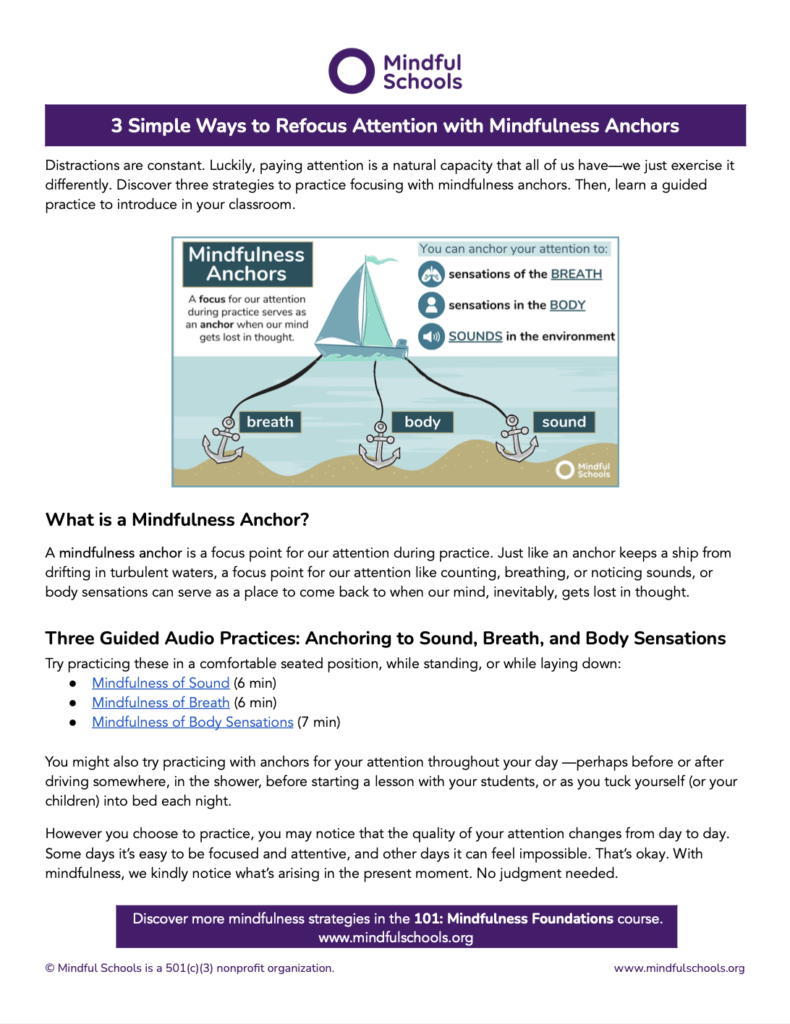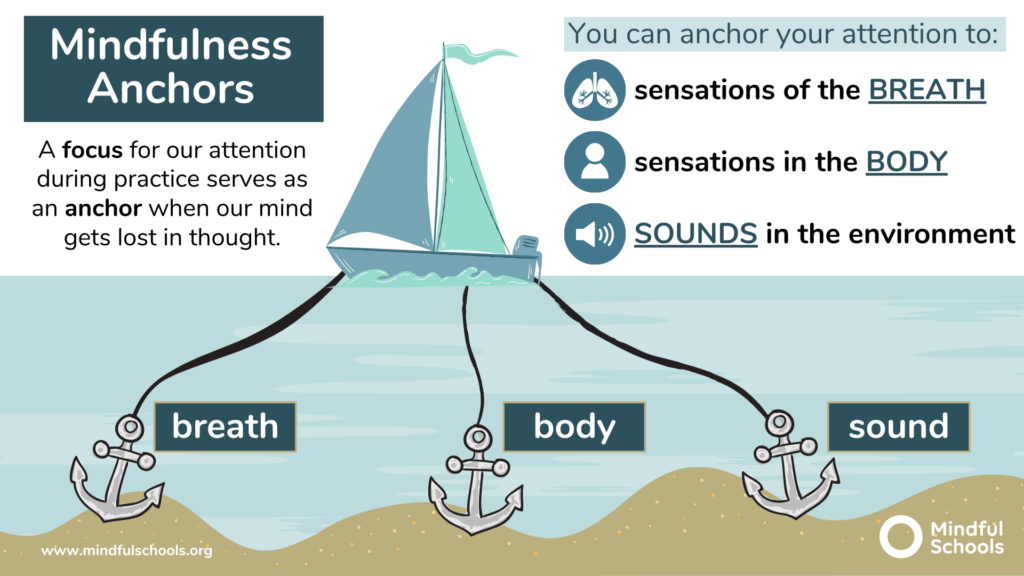Distractions are constant. Luckily, paying attention is a natural capacity that all of us have––we just exercise it differently. Discover three strategies to refocus attention with mindfulness anchors. Then, learn a guided practice to introduce in your classroom.

Mindful Schools: Mindfulness Anchors in the Classroom PDF

Attention and Distraction
A core component of mindfulness is paying attention. Though we may feel like we’re constantly distracted, this ability to pay attention is a natural capacity that all of us have.
Though we all possess this capacity, we probably notice that we’re often not really aware of what is happening with our thoughts, bodies, or the people and environment around us. We may be distracted, worried, or simply too busy to notice, for example, tension in our body that might indicate some anxiousness due to our train of thought. We may not even be aware that we’ve been caught up in those thoughts!
This distraction means we miss many important aspects of our present moment experience. Mindfulness practices strengthen our attention “muscles,” and help us shift our attention in ways that are resourcing and supportive.
For example, when we become aware we’re thinking about our schedule or to-do list, we may also notice some tightness in the shoulders or feelings of anxiety. Once we realize we’re having these experiences, we can take some deep breaths, relax our muscles, and choose whether we want to keep thinking about our upcoming tasks, or if it would be more supportive to anchor our attention on something else.
Educators, Explore Mindfulness in our 101 Course
In 101: Mindfulness Foundations, learn practices that can resource you during the school day and daily life, with trauma-sensitive approaches for navigating emotons, working with thoughts and biases, and cultivating compassion and joy. Educators earn credits.
Bring Mindfulness to Your Classroom
In 201: Mindfulness in the Classroom, learn trauma-sensitive strategies to nurture social and emotional well-being in your classroom. Access the Mindful Schools K-12 Curriculum and Teaching Kit. Educators earn credits.
What is a Mindfulness Anchor?
A mindfulness anchor is a focus point for our attention during practice. Just like an anchor keeps a ship from drifting in turbulent waters, a focus point for our attention––like counting, breathing, or noticing sounds or body sensations–can serve as a place to come back to when our mind, inevitably, gets lost in thought.
3 Guided Audio Practices: Anchoring to Sound, Breath, and Body Sensations
Try practicing these in a comfortable seated position, while standing, or while laying down:
You might also try practicing with anchors for your attention throughout your day––perhaps before or after driving somewhere, in the shower, before starting a lesson with your students, or as you tuck yourself (or your children) into bed each night.
You may notice that the quality of your attention changes from day to day. Some days it’s easy to be focused and attentive, and other days it can feel impossible. That’s okay. With mindfulness, we kindly notice what’s arising in the present moment. No judgment needed. This curious exploration of attention, along with the insight that we have a choice in where we place our attention, is often described by educators in our courses, and their students, as a powerful benefit of their mindfulness practice.
Discover more mindfulness strategies and guided practices in the Mindful Schools 101: Mindfulness Foundations course.
Practicing with Mindfulness Anchors in the Classroom

Join the Mindful Schools email list to receive this practice as a printable PDF, in the purple box at the top of this page. Then discover the full Mindful Schools K-12 Curriculum in the 201: Mindfulness in the Classroom course.
Mindful Listening: Guided Classroom Practice
Mindfulness anchors are a strategy we explore in multiple lessons in the Mindful Schools K-12 Curriculum. One of the first anchors we teach is mindful listening, or sound, with a teacher-led practice and classroom discussion.
Start with this guided practice to introduce mindful listening to your students. You’ll need a bell or chime to ring, or you could use an app with bell sounds.
Take a moment to settle into a comfortable position. In just a moment, I’ll ring the bell. [Ring bell.]
What did you notice? Would you like to hear it again?
Okay, but this time, turn your mindful ears on. That means you listen very carefully, the whole time. So, see if you can pay attention from the very first moment you hear the bell all the way to the end. Raise your hand when the sound is gone. [Ring bell.]
Notice if that was easy or hard. Let’s try it one more time with our eyes closed or gazing down at the floor. So right now let your eyes close or let them gently gaze down, whichever feels better for you right now. Listen just like you did before to the entire sound, and raise your hand when the sound is gone for you. [Ring bell.]
We can also listen this carefully to any sound. There are lots of sounds around us all the time. If we listen very carefully, we might hear things we don’t normally hear. Let’s keep our mindful bodies on, with our eyes closed or gazing down, and listen to the sounds around us. We might hear sounds in the classroom or outside, or even in our own bodies.
[Mindful Listening for about one minute.]
In just a moment, I’ll ring the bell one more time to end our mindful listening practice.
Classroom Debrief
After each practice, the Mindful Schools K-12 Curriculum offers questions for classroom discussion that allow students to make sense of the experience they had in the guided practice. Use these prompts to allow students to report out about their experience, validate and support their experiences, and help students make connections to the qualities of mindfulness they noticed in practice (awareness, observation, acceptance, openness, compassion, kindness, etc.).
Mindful Listening: Classroom Debrief Question
What are the sounds around me?
Share with someone next to you about some sounds that you noticed.
Who would like to share what they heard?
What did it feel like to simply listen for sounds?
Sound can be a mindfulness anchor. An anchor helps keep a boat where it is. If the boat starts to drift away, the anchor pulls it back in. That is what sounds are doing for our minds. Sometimes when we try to focus on the sounds around us, we might find that our minds start thinking instead of focusing on what we can hear. When our minds wander away from sounds or start to think about things, we can notice it and bring our attention right back to our anchor.
Join the Mindful Schools email list to receive this practice as a printable PDF, in the purple box at the top of this page. Then discover the full Mindful Schools K-12 Curriculum in the 201: Mindfulness in the Classroom course.

UPCOMING WORKSHOP:
Mindful Games for your Classroom
Wednesday, April 24, 2024 at 4pm ET
Join us for this dynamic 90-minute training to experience mindfulness through play to evoke curiosity, spark creativity, foster engagement, and support learning.


